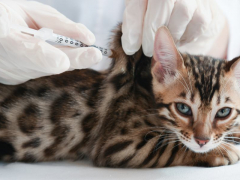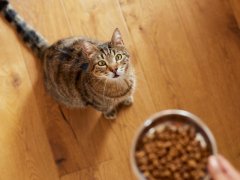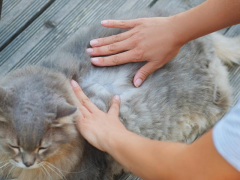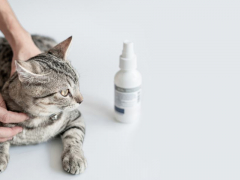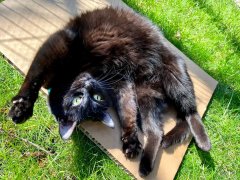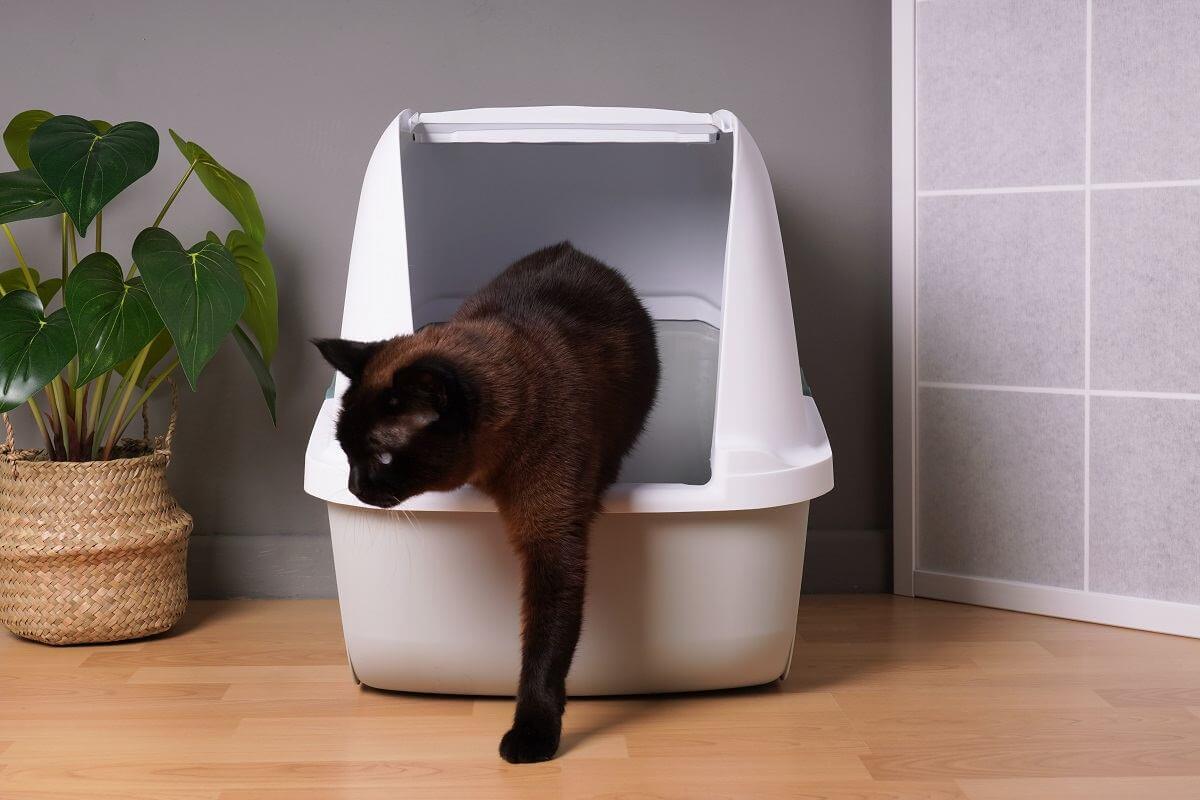
If your cat is having a tough time in the litterbox, check to see if stools look harder or larger than normal. Axel Bueckert / Shutterstock.com
It’s never fun to watch your cat straining to have a bowel movement. Anyone with experience with even occasional constipation knows how uncomfortable it can be. Laxatives are a type of medication often used in constipation cases to ease bowel movements.
A cat laxative may be a therapy your cat could use if you’re seeing occasional or recurrent constipation. In this article, we’ll go over a few different types, when they may be used, when to see your vet, and some frequently asked questions.
Laxatives For Cat Constipation Overview

Why Do Cats Get Constipated?
Constipation is where a cat has difficulty in passing feces, with bowel movements often small, dry and hard. It is not uncommon in cats, and can develop for a variety of causes. Common reasons for constipation in cats include:
- Poor hydration
- Poor activity/lack of exercise
- Stress and anxiety
- Hairballs
- Low dietary fiber
- Thin body condition
- Obesity
- Inflammatory bowel conditions
- Foreign material
- Pelvis trauma
In my own experience, I most commonly see constipation in cats that are either very overweight or very underweight. Underweight cats often have an underlying condition that leads to muscle weakness and dehydration, like kidney disease or diabetes. Megacolon is a condition that results from chronic recurrent constipation. When the colon wall is stretched repeatedly over time, it loses its functional ability to move stool through.
Obstipation is a term reserved for when a cat cannot physically poop. While constipation may mean it is difficult to defecate, this does not mean a cat cannot do it, at least with a little help. But with obstipation, stool is too large and firm for a cat to poop on their own without medical intervention. This can also be considered a fecal blockage.
Types of Laxatives
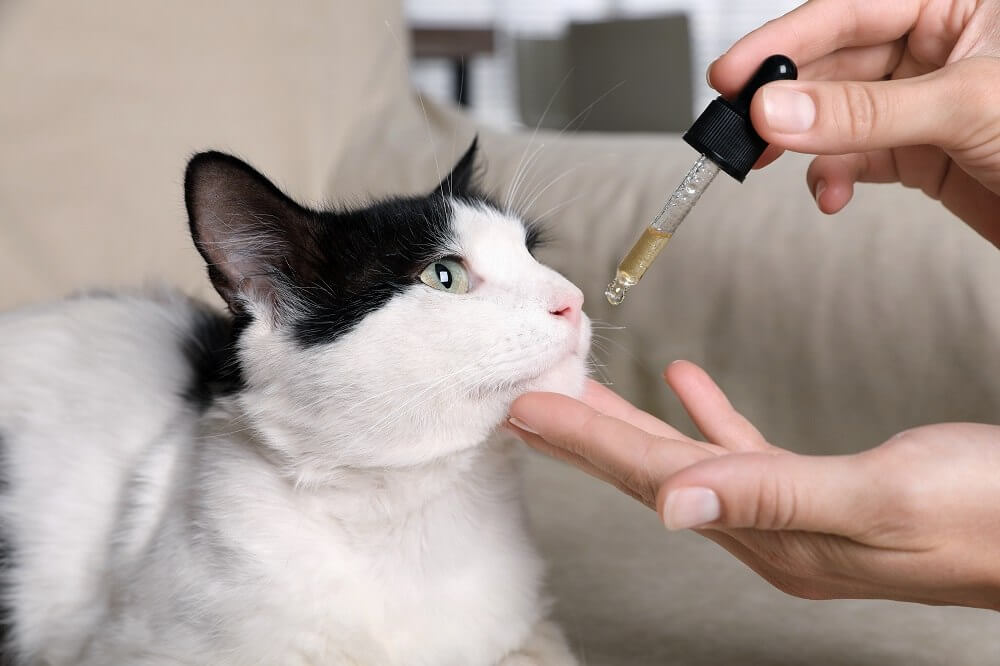
Some liquid laxatives may be given by mouth. New Africa / Shutterstock.com
A laxative is a substance that encourages bowel movements. Because there are different ways to make this happen, there are a few categories of laxatives.
1. Lubricant Laxatives
Lubricant laxatives work by softening and/or coating the stool to allow it to pass more easily. They generally have minimal impact on the bowel itself. Examples include:
- Mineral oil (Laxatone)
- White petrolatum (Laxatone, Cat Lax)
2. Emollient Laxatives
An emollient laxative is one that enhances fat absorption into the colon while preventing loss of water from the colon. This helps to lubricate stool and allow it to pass more easily. One example includes:
- Colace (docusate sodium) also referred to as dioctyl sodium sulfosuccinate (DSS)
3. Cathartics
Cathartics are generally agents that increase colon movement. Under this broad category there are a few different types.
Osmotic Laxatives
Osmotic laxatives help to draw more water into the colon which helps to moisten stool and encourage evacuation of bowel contents. Examples include:
- Miralax (PEG or Polyethylene glycol 3350)
- Lactulose
Stimulant Laxatives
Cause stimulation of nerves and muscles within the bowel, enhancing forward motion of the bowel and evacuation of bowel contents. One example includes:
- Dulcolax (bisacodyl)
Mucosal Stimulants/Irritants
These laxatives cause irritation and stimulation of intestinal cells, leading to water influx into the intestines. I avoid use of these in cats because their mechanism of bowel irritation may contribute to more side effects (cramping, abdominal discomfort, etc.) One example is:
- Sennosides (Senokot)
Pro-Motility/Prokinetic Agents
These are medications that work directly on nerves and muscles to stimulate forward motion of the intestinal tract. The following may both be used in cats, though cisapride use is much more common:
- Cisapride
- Ranitidine
Bulk-Forming Laxatives
Bulk-forming laxatives essentially describe using soluble fiber as a way to encourage bowel movements. Soluble fibers absorb water, soften the stool, and add bulk, which stretches the colon and stimulates muscular movement. Examples include:
- Psyllium
- Wheat bran
- Pumpkin
Enemas
Enemas or suppositories may still be considered a type of laxative, though they are administered rectally to encourage evacuation of bowel contents. Few cats will tolerate enemas easily at home but they are commonly employed at veterinary hospitals as a first line treatment for constipation when efforts at home fail. Some examples include:
- Lube/Glycerin products (generic lubricating jelly, Surgilube)
- Mineral oil
- DSS (dioctyl sodium sulfosuccinate)
10 Laxatives for Cats
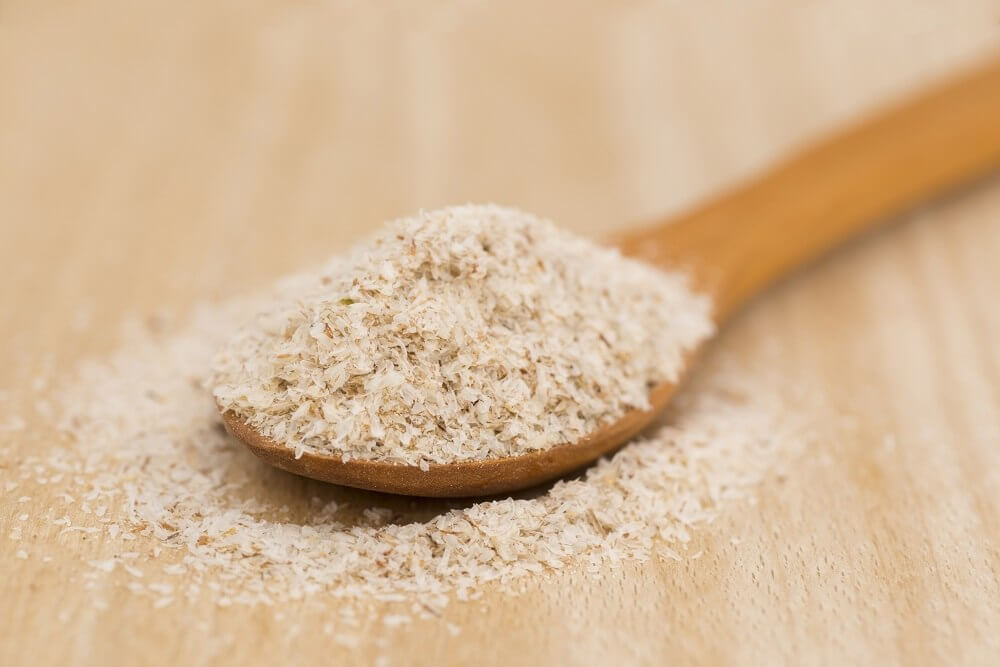
Psyllium, a form of soluble fiber, is one type of bulk-forming laxative. florin oprea / Shutterstock.com
The following list include the most common and preferred laxative agents that can be used in cats. Keep in mind that none of these carry FDA approval for cats and are all considered extra-label or off-label. You should always consult with your veterinarian before starting a laxative or significantly altering your cat’s diet, even when using over-the-counter products.
The following information provided should not take the place of an attending veterinarian’s advice or therapeutic plan. Multiple factors, including the cause of constipation and your cat’s overall health, will affect laxative choice.
1. Mineral Oil
The most common type of product, mineral oil, is one originally designed for cats as a hairball remedy. These are usually given directly by mouth or can be applied to the fur on a cat’s foot to encourage them to lick it off. An example of this is Laxatone.
Pure mineral oil may be used cautiously by adding about 1 teaspoon mixed with canned or soft food. Never administer pure mineral oil directly by mouth. If any goes down the wrong tube and is inhaled, mineral oil can obstruct airways and lead to severe pneumonia.
While mineral oil can be given rectally as an enema or suppository, I usually dissuade pet owners from trying this at home. Anything inserted into the rectum forcefully can cause rectal or colon tears. Most cats will also react badly to attempted enemas, causing undue stress and the potential for cat and owner injury.
2. White Petrolatum
This is another lubricating ingredient commonly found in hairball remedies like Laxatone and Cat Lax. It can help with signs of mild constipation. These types of products can be given regularly for cats at risk of constipation.
3. Dioctyl Sodium Sulfosuccinate (DSS)
This emollient laxative allows fat absorption while retaining water, helping to lubricate the feces while contributing to colon volume and evacuation of stool. It is most commonly available as an enema or suppository for pets. Although available without a prescription, any suppository should be used under veterinary supervision. I don’t recommend their use at home if you have no experience administering one to a cat.
The human oral product Colace (which appears as the generic docusate sodium) may be used at 50mg (per cat) every 24 hours.
4. Miralax
The generic name for the brand Miralax is PEG or polyethylene glycol 3350. While they sound similar, do not confuse this with ethylene glycol (antifreeze), which is toxic to cats. Miralax is generally very safe to use but the dose is very low compared to what a person would take. Cats typically only need ⅛ to ¼ teaspoon every 12-24 hours to help relieve constipation. Regular use may be an option for some cats, but you should consult with your vet before giving it routinely.
Another form of PEG under the brand GoLytely also contains electrolytes and is administered orally through a nasogastric tube in a hospital setting to treat severely constipated or obstipated cats. This is the preference by some veterinarians instead of de-obstipation procedures with repeated enemas and manual removal of stool.
5. Lactulose
Like Miralax, lactulose also acts as an osmotic laxative, drawing water into the colon. Lactulose is a syrupy liquid which can be given directly by mouth. Many cats dislike the taste of it and it can leave a sticky residue on the fur. It is a prescription item with appropriate dosing determined by your veterinarian.
6. Dulcolax
Dulcolax is the brand name for biscodyl, a stimulant laxative. One 5mg tablet may be given once daily for cats to relieve episodes of constipation, but is not suggested as a long-term solution. These tablets cannot be broken or crushed.
7. Cisapride
Cisapride is a promotility agent that has the greatest effect in cats on the colon. It is very common to use regularly for cats with chronic constipation and especially with megacolon. Cisapride is only available through compounding pharmacies with dosing determined by your vet.
8. Psyllium
Psyllium is a type of soluble fiber. The most recognized product is Metamucil. Metamucil can be added to food at 1-4 teaspoons per meal. I always suggest using the unflavored product. The nice thing about psyllium is that it can be used regularly as part of the diet.
9. Wheat bran
Wheat bran is a mix of soluble and insoluble fiber. This can be added at up to 1 tablespoon with each meal. Generic wheat bran can be found in many places. Fiber One cereal is also a source that I have found appears to be palatable for many pets.
10. Pumpkin
Pumpkin is also a mix of soluble and insoluble fiber. Its result is more unpredictable as some pets may respond to a small amount as a supplement while others need larger amounts to see benefit. I only suggest using up to 1 tablespoon per meal for a cat.
Larger amounts can be detrimental, as you may actually end up feeding your cat more actual pumpkin than their primary balanced diet. Always make sure to use pumpkin puree or canned pumpkin and not pumpkin pie mix, which has added spices, sugar, and other ingredients.
Side Effects of Laxatives for Cats
In general, any laxative can lead to some common side effects like abdominal discomfort/cramping and diarrhea.
Most laxatives should be used cautiously or avoided in cats with signs of significant dehydration. Many laxatives can lead to water loss into the colon or water retention, leading to further dehydration. This is especially relevant to cats with kidney disease, hyperthyroidism, or diabetes. If your cat has any chronic health concerns, make sure to discuss options with your vet.
You should also avoid use of most laxatives if there is any concern for an intestinal blockage, including a fecal blockage.
If you are giving other medications with a laxative, try to give the laxative separately – a time gap of around two hours is advisable. Given what laxatives do, they can lead to altered absorption of other medications.
What To Avoid as a Laxative for Cats
Phosphate (Fleet) enemas should always be avoided in cats as they will cause a toxically high level of sodium and phosphate, causing severe electrolyte abnormalities, muscle stiffness, and weakness. Since they are over the counter and used often by humans, toxicities occur in cats when these are used in error at home.
If you have used a Fleet enema in your cat, immediately contact one of the following for assistance:
- Your veterinarian
- ASPCA Animal Poison Control Center (1-888-426-4435)
- Pet Poison Helpline (1-855-764-7661)
Cooking oils, including vegetable oil, olive oil, canola oil, etc should also be avoided – as they are actually absorbed and digested, these oils are unlikely to help with constipation. Small amounts (1-2 teaspoons) are unlikely to cause a problem, but large amounts will cause bowel irritation and digestive upset.
When To See a Vet
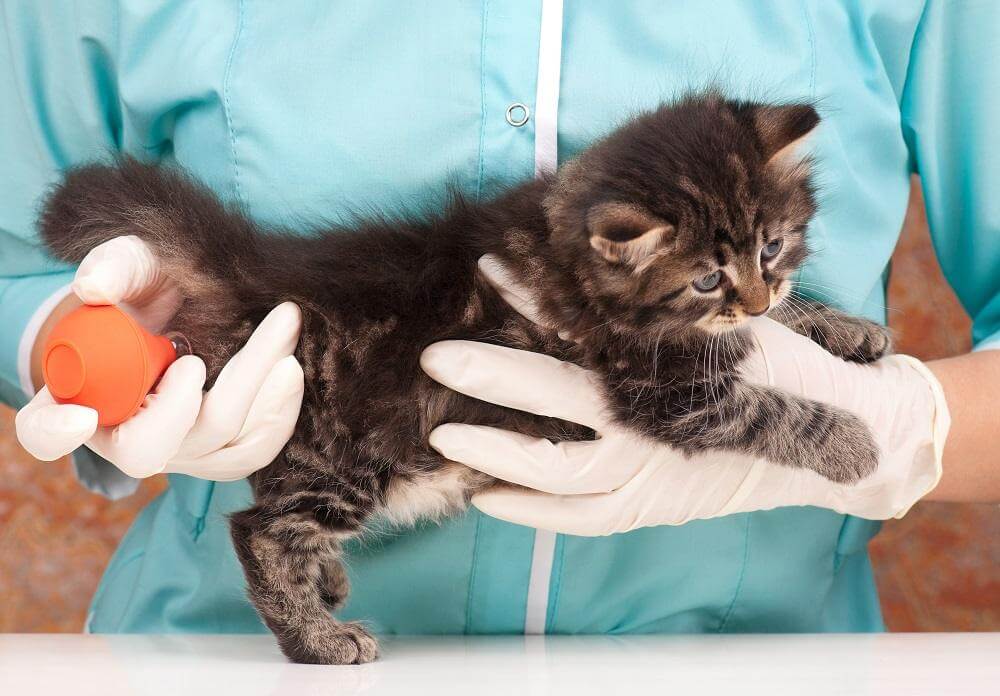
If home efforts to relieve constipation don’t help within 24-48 hours, your cat should receive veterinary attention. Lubava / Shutterstock.com
Home care for a constipated cat can be acceptable if signs of constipation are occasional or mild. Many cases will resolve rapidly with minimal intervention. As well as using laxatives, try increasing water intake, such as by switching to wet food or adding more water bowls and/or water fountains, and encouraging physical activity.
However, there are a few instances where veterinary care is necessary.
- Little to no urine production: Difficulty with urination or even a urinary blockage can be easily confused with constipation because the behaviors of frequent litter box use attempts and signs of straining are very similar. A urinary blockage can easily become fatal within 12 hours, so if your cat is showing a change in litter box use especially with straining or vocalizing, always ensure there is urine present before assuming cat constipation is the problem. If you’re not sure, it’s best to take your cat for a veterinary exam to ensure a urinary blockage is not present.
- No bowel movement within 24-48 hours: In cats urinating normally, not seeing poop within 48 hours despite some home care attempts warrants a veterinary exam to determine a fecal blockage diagnosis.
- Vomiting: Cats with either urinary or fecal obstruction may develop signs of vomiting and poor appetite. This should always be a sign of an immediate concern for a veterinary exam.
- Megacolon: If your cat has been diagnosed with megacolon, you may already understand that management of the condition can be challenging. While medication and other strategies help, megacolon typically worsens over time even with proper medical therapy. Any signs of difficulty pooping in a cat with megacolon should warrant a check-up. Medications used for megacolon, like cisapride, can be a problem to continue giving if a fecal blockage develops.
-
A Stern, L. (2015, May 27). Hypertonic phosphate enema intoxication in dogs and cats. DVM360. Retrieved March 14, 2024, from https://www.dvm360.com/view/hypertonic-phosphate-enema-intoxication-dogs-and-cats
-
Brooks, W. (2023, January 31). Constipation and Megacolon in Dogs and Cats. Veterinary Partner. Retrieved March 14, 2024, from https://veterinarypartner.vin.com/default.aspx?pid=19239&id=4951509
-
C Plumb, D., A Budde, J., & M McCluskey, D. (n.d.). Plumb’s Veterinary Drug Handbook (10th ed.) [App]. Wiley Blackwell.
-
Constipation. (n.d.). Cornell Feline Health Center. Retrieved March 14, 2024, from https://www.vet.cornell.edu/departments-centers-and-institutes/cornell-feline-health-center/health-information/feline-health-topics/constipation
-
Constipation in Cats: Causes, Symptoms, and Treatment. (n.d.). AnimERge. Retrieved March 14, 2024, from https://www.animergevets.com/site/blog/2021/01/15/constipation-dogs-causes-symptoms-treatment
-
Dar, S., & R Dalton, H. (2005). Toxic Exposures: Fleet Enemas. Side Effects of Drugs Annual, 28, 401–414. https://www.sciencedirect.com/topics/pharmacology-toxicology-and-pharmaceutical-science/fleet-enema#:~:text=Phosphate%20enemas%20
-
Defarges, A. (2022, October). Constipation and Obstipation in Small Animals. Merck Veterinary Manual Online Professional Version. Retrieved March 14, 2024, from https://www.merckvetmanual.com/digestive-system/diseases-of-the-stomach-and-intestines-in-small-animals/constipation-and-obstipation-in-small-animals
-
Highlights of Prescribing Information: GoLYTELY. (n.d.). FDA. Retrieved March 14, 2024, from https://www.accessdata.fda.gov/drugsatfda_docs/label/2013/019011s025lbl.pdf
-
Ogbru, O. (n.d.). senna (sennosides). MedicineNet. Retrieved March 14, 2024, from https://www.medicinenet.com/sennosides_aandb-oral_tablet/article.htm#what_is_sennosides_ab-oral_tablet_and_how_does_it_work_mechanism_of_action
-
Scherk, M. (2015, March 11). All bunged up: Unclogging the constipated cat. DVM360. Retrieved March 7, 2024, from https://www.dvm360.com/view/all-bunged-unclogging-constipated-cat
